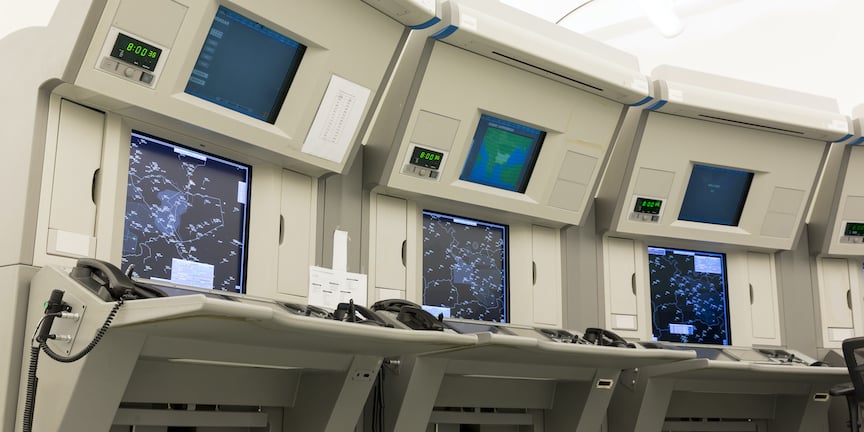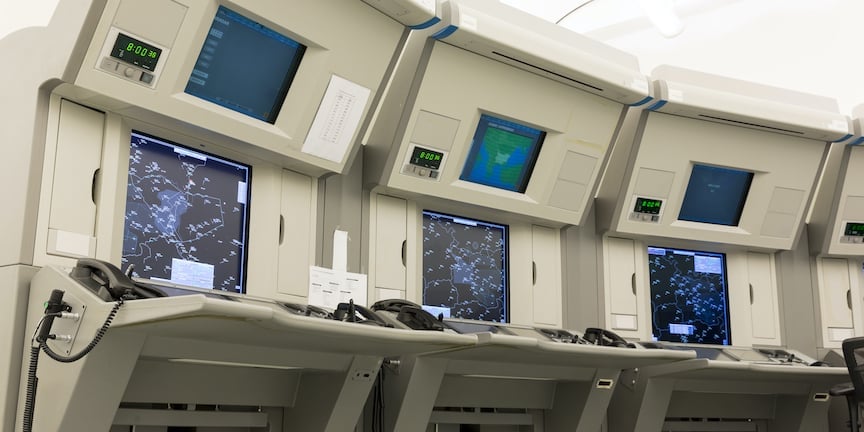This article initially got published on the 22nd of March 2020, at the beginning of the COVID lockdowns. It has been reviewed on the 26th of December 2022, without changing the conclusions.
As most of us are working in home-office to slow-down the propagation of the Corona virus, the idea of having air traffic controllers working from home naturally came up. Now that remote towers are a reality and that virtual centers are discussed and getting developed, why not? Let us go through what it would mean to have air traffic controllers joining the home-office club. This will obviously not happen this time around, but what about the next crisis?
Radar and flight plans
Looking at the technicalities first, let us assume that connectivity and bandwidth between the ANSP head quarters and our ATCO's home is guaranteed. Network engineers certainly frown at this idea. ATC is not like streaming a movie from Netflix: buffering can not be used to cover for small delays and interruptions are not an option. Showing a spinner on the radar screen is absolutely not possible, nor waiting for 10 seconds when you "start the stream" Typical performance requirements allow for a maximum of 4 seconds from radar detection to an update on the controller's screen, and this is rather tight when you consider all the processing steps. The cybersecurity aspects of opening ATC networks to connections from anywhere are also rather challenging, but not impossible.
But assume the network issues is solved.
Most ATC systems run on more or less standard hardware and it would even be possible to use centralised hardware and remote display and control technologies like VNC or remote desktop to provide the ATCOs with the applications they need. This would actually be easier than installing any software locally, with different hardware, which would require a lot of support. A simple PC and a large screen at home would be enough. But how large? A typical 2k x 2k screen is rather a TV than what a typical individual has on his home PC. Remote towers could be a challenge though, but the equipment would make for a great home-cinema outside of the working times ;-).
Assuming a stripless environment, this would cover for surveillance and flight plan processing. Having strip printers at home would be less than practical and passing paper strip to a colleague after one's shift end would simply not be possible.

The above assumes that no specific hardware is involved. Is this a valid assumption? Many ATC systems use custom hardware to allow inputs to be done faster. Some use small touchscreens, other have mice with specific configurations or keyboards with custom layouts. One could provide ATCOs with such devices at home but the logistics of it would not be easy. What about failures, spare parts and replacements?
Voice communication systems
Telephone communications are a bigger challenge. Typical ATC telephones use custom made HMI panels with shortcuts for frequently use numbers. Calling another sector or a neighbouring center at the push of a button is a must. The communication system must be quick and allow for fast dialings. Could a tablet-based application fulfil that need? Technically, this is likely feasible. Tablets support audio communications and their screen size is similar to ATC telephone HMIs. And if tablets can manage telephone, they can also manage VHF and UHF radio communications, with a proper push-to-talk button or pedal.
Redundancy
Getting the technical setup - including the network connection - in a redundant way with levels of safety similar to existing ATC facilities would be more than a challenge. It would imply redundant internet connections and redundant power supply with batteries. At each ATCO's home. Add system monitoring and control, backup systems and legal recording to the mix and the amount of hardware required further increases. Nothing technically impossible but far from practical.
Direct communication
ATCOs are not working only with technical equipment but also with colleagues around them. En-route sectors are typically operated by two controllers, one executive controller and a planner, working closely together. Shall the two be in a permanent teleconference from home for the time of their shift? This is unlikely to be a valid substitute for direct conversation and would make it hard to include telephone and radio. The same applies to approach and departure controller, and for tower and ground. Some units even have extra coordinators doing nothing else than verbal communication with colleagues. A constantly open teleconference with three or more people? This is not the like as seating in the same room, as one can't perceive where a voice is coming from and therefore not understand immediately who is speaking. We also all know in between that Zoom and the the like have a latency time of roughly half a second and that it is not that easy, not to interrupt other people.
In many centers, working positions are arranged in a way allowing for direct discussions between sectors without using telephone.
Shall then ATCOs working from home have various teleconferences, depending if they want to talk with their direct colleagues or with someone working another sector? How would prioritisation work? Add to that supervisors coming to sectors when required, grouping and de-grouping of sectors, handovers and on job training, which all require tight communication and the need to point to things on screen when explaining something to colleagues - can all this be handled without physical presence?
Workplace at home
If you work in home-office right now, you also know how different it is from the usual office work. With distractions around, working non-stop in a focused way is all but easy. The flexibility that home-office offers can be positive and help with productivity but use of time is different with each task. Home-office is fine when work can be interrupted, be it for a few minutes or more, making the best possible use of time. Working on an article, a report or an analysis in home-office can even be easier than in a normal office environment. But when a task can absolutely not be interrupted and must be done in real time, home-office is not a good solution. Unless each ATCO working in home-office has a dedicated room for work from, this is all but practical.
Ergonomics also plays a major role in the design of air traffic control working positions. The position of the screens, keyboard(s), mice are designed with care, like seating and lighting. This is hardly possible to control and reproduce at home and could lead to additional fatigue or distractions.
When considering home-office for air traffic controllers, one must also consider cases when things go wrong. ANSPs have internal crisis management and this includes the possibility to immediately relieve an ATCO in case of incident. Not only reserve ATCOs are present but peers are also available to take care of the colleagues involved in the incident. One more thing that is much better done in person than over a teleconference.
Remote yes, but not from anywhere
The technical features required for ATC can likely be made available anywhere, with a couple of assumptions. But a proper working environment is not limited to technical features and all what is required for a working ANSP can not be replicated at each ATCO's home.
Remote Towers are about having the tower cab somewhere else than on top of a concrete column at the airport's center. Not there, but not anywhere. Virtual centers are about controlling any airspace from any ATC center. Not from anywhere, not without infrastructure. Overcoming the infrastructure issues would likely make any business case not viable financially.
Even if teleconferencing technology did make great progresses, they do not replace the kind of presence required for an operational air traffic control facility.
In conclusion, air traffic controllers will not be part of the working from home crowd anytime soon.




